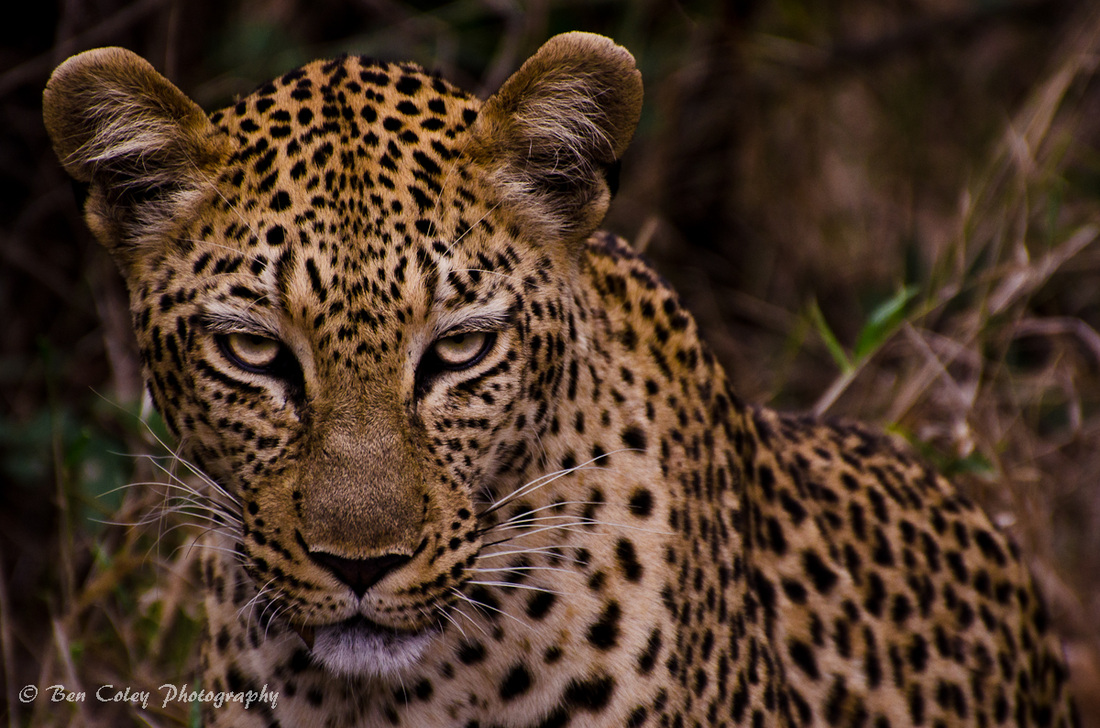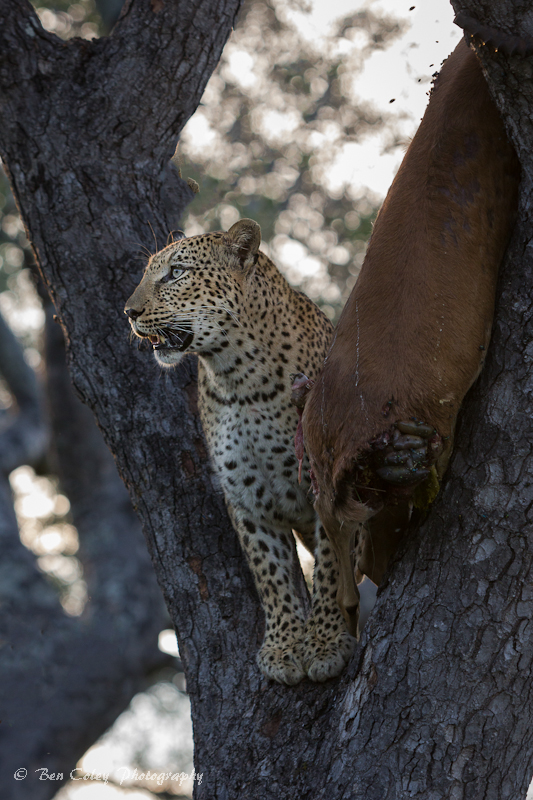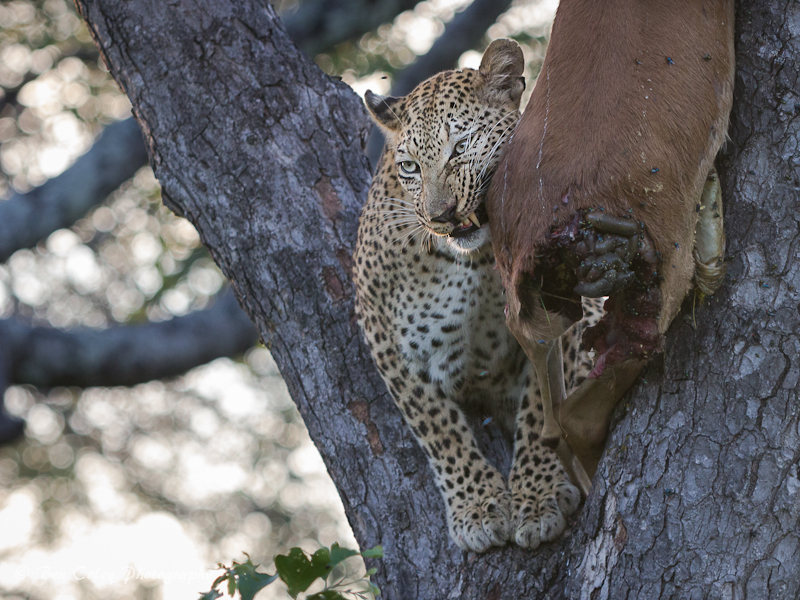|
Imagine having to leave your young children at home alone for prolonged periods while you head out to search for food; a quest that might take days to accomplish. Imagine leaving your children exposed and alone in a rough neighbourhood whose occupants wouldn’t think twice about securing a quick meal or at least removing their competition. Imagine a home where you have no dead lock, no home security system, no friends to call on to babysit and no police force to ‘protect and serve.’ Couple all these terrifying factors with children who are born with a natural independence and rampant curiousity and you have a recipe for disaster. The life of a leopard mother is tough. Despite all these horrifying thoughts that she has to contend with, the need to procure food outweighs all of the potential risks and each time that she returns to her cubs, the discovery that one or all of her offspring have perished is very real. Animals however are blessed with a narrow mindedness that we will never be able to fully appreciate. Their life is simplistic: find food for yourself; find food for your cubs and protect them from the dangers that lurk in the African bush. We have no idea how strongly animals feel loss but it is something that every leopardess will have to learn. With mortality rates as high as 80% in some areas, the chances of raising one cub to maturity is slim, but a leopard’s biology means that she will never give up until her final breath escapes her beautiful body. Xikavi is stunning leopard from the western sector of the Sabi Sands and she is in the midst of this eternal struggle as we speak. I have been fortunate enough to follow her progress over the last few months thanks to frequent visits to the area and have experienced both heartache and loss watching her try to provide for her new family. Around 4 months ago, Xikavi introduced us to her 2 beautiful cubs. Alas, 2 quickly became 1 due to what we believe to be a snake bite. I was privy to witness a heartbreaking scene about 3 months ago when we followed her to her den site where she found 1 happy cub eager for her return, and 1 lifeless body. Her attempts to revive her lost cub were in vain and we watched in heart-breaking sympathy as its sibling nuzzled and nudged its former companion trying to understand its motionless. Despite her loss she had no time to wallow in self-pity and regret. Her last remaining cub needed her more now than ever before, and for the last 3 months, Xikavi has dutifully provided for her legacy. The thick undergrowth, fueled by the summer rains, has given her the ability to disappear. Her perfect camouflage allows her to become one with her surroundings and on this occasion, nature’s silent assassin made no mistake. As we rounded the corner, we were met with the somewhat gruesome sight of a half-eaten impala hanging in the fork of a tree. No leopard was to be seen, but the bush’s opportunists had already arrived. An elegant yet powerful Bataleur eagle occupied the kill, using its strong beak to tear flesh away from body. Every animal must suffer the same eternal need to survive and, in the wild, an unattended carcass does not remain unattended for long. Soon after we arrived, movement distracted us. Like a mirage, a sleek form was slowly taking shape as it weaved effortlessly through the dense undergrowth. When it saw that its hard-earned food had been compromised, it leapt from the shadows, bounding with ease up the tree like a velveteen simian. The troublesome Bataleur erupted from the branches in a cloud of feathers as it sought refuge from the razor sharp teeth and swiping claws. Xikavi had returned from quenching her thirst and reclaimed her prize. We watched in awe as she negotiated the tree limbs with the poise of one quite at home in the treetops and settled down to watch her feed. The sighting was not for the faint hearted however. The antithesis of nature is all around us, and the majestic sight of this beautiful creature feeding high above the ground was neatly coupled by the demise of the impala. As she maneuvered the carcass, various internal organs were loosened and began to emerge from their host’s body, culminating in a sickening thud as the stomach slowly succumbed to its own gravity and landed on the floor only meters from us. Despite the obviously revulsion felt by most, this is life. The impala would not live, but its sacrifice would go far in replenishing essential energy for its killer, and more importantly, for her cub. Although we did not get to see the other beneficiary, the other vehicles did say that after dark, Xikavi returned to the kill with her cub in tow and the 2 of them were able to feast in peace. Despite the odds and the danger, Xikavi continues to do everything in her power to supply her cub with the nutrition and safety that it needs to grow. Should she be able to provide for it for another 18 months, her biological clock will tell her that the time has come for the cub to move on. The cub will not understand why the apron strings are being cut so painfully but it will be the first of many lessons as it embarks on its lonely life of solitude. Xikavi will receive no thanks for the duties that she performs but she will have done all that she can do. Her thoughts now will be focused on repeating her actions and continuing to expand her genetic reach. The life of any mother is hard but to be a single mother in the midst of the war zone that is the African bush must be supremely taxing. Xikavi, I salute you. By Ben Coley, Leopard ID Project Ambassador and Host
2 Comments
One of the most fascinating facets of a safari experience is watching the highly skilled trackers interpret the bush from the signs left behind on the road. The art of tracking is acquired skill and whilst some are blessed with natural ability, as in all skills, it is not something that can be learned from a book. Most of the local trackers working in the Kruger area have grown up in the area and been taught by their fathers and also attended courses to refine their skills. For many, looking after the family’s cattle as a child has helped to develop their abilities and one of my former trackers once told me that his responsibility was to find the cattle each morning and this meant learning to distinguish his father’s cattle from the neighbour’s, merely by looking at the spoor!? The most commonly tracked animals on safari are the lion and leopard. Both belonging to the cat family (felidae) they share many similarities (taxonomy uses foot structure as one of its classification methods). The 2 main clues that the trackers look for when identifying a track are the back pad and the presence or absence of claws. All cats, from your cute little kitty-kat at home to the lions and leopards that roam the African bush, have 3 lobes on their back pad. Only the felines display this trait and for those of you with domestic cats, you are welcome to check this! The dog family (canidae) and hyena family (hyenidae) only have 2 lobes. With a large number of hyenas wandering through the landscape after dark, this is the first detail of the track to check to eliminate misidentifying the spoor. The second important characteristic to check is whether there is any evidence of claws. All cats have retractable claws and thus, any lion or leopard track will show no trace of claw impressions in the substrate. Dogs’ and hyenas’ claws are always exposed and in the soft sandy roads of Sabi Sabi, they are usually visible, thus enabling us to achieve a positive identification. There are exceptions to every rule of course…the cheetah has 3 lobes on its back pad and semi-retractable claws which do leave impressions in the substrate. This however, makes it easy to recognize as is the only animal here to have both traits. Once the track has been established as a ‘cat track’, the next part of detective work is to identify the species involved and this is done simply by size. A large male lion for example can reach over 200kgs whilst a large male leopard 80kgs. Therefore, a lion track is much larger than a leopard’s as a larger surface area is needed to carry this extra body weight. In both species, size again should be able to define the sex due to the weight difference between males and females. Specifics can also be assumed due to the individual characteristics of the track. For example, in all animals, the front feet are larger than the back due to the weight of the head and shoulders and this will be reflected in the shape of the spoor. The front paw of a lion will be far larger and broader than the back. Right and left can also be distinguished by looking at the toe arrangement. If you look at your own hands for reference, you will see that your outside finger (i.e. little finger) is the shortest. This is exactly the same in animals and so if you can identify which toe is the shortest or closest to the pad, this will show you whether it is the right or left paw. This picture shows both male lion and male leopard tracks. The larger track on the right is from a male lion and due to its size, we know that it is the front right foot by looking at the details: the impression is too large and broad to be a back foot and you should clearly see that the furthest right toe is the shortest, thus telling us it is a right front foot. The tracks to the left are from a male leopard. Here you can clearly see the size difference between the two cats. The track the closest to the bottom of the photo is the front and the one in front is the rear foot. Again, you can see the size difference between the two and at a standard walking gait, the back foot usually outpaces the front. This will obviously change should the animal be trotting or running. The front paw’s toes are obscured by the standing water but in the back foot, again it is the furthest right toe that is closest to the pad and thus can be assumed to be a right paw. The art of tracking is not something that can be learned in a book and can only be achieved through experience. The interpretive skills of trackers are fascinating and guests and rangers alike can learn so much from these wise men. They are the CSI division of the safari department! Where they really come into their own is with aging the tracks. They will look for signs of weathering from environmental factors and the presence of other tracks on top of the spoor to name a few. The trackers are the unsung heroes of the bush and whilst your ranger can explain the bush to you, these elite men can read it better than anyone.
|
Authors:Leopard statuses and happenings by Leopard ID Project team leaders. Archives
October 2014
Categories |










 RSS Feed
RSS Feed
